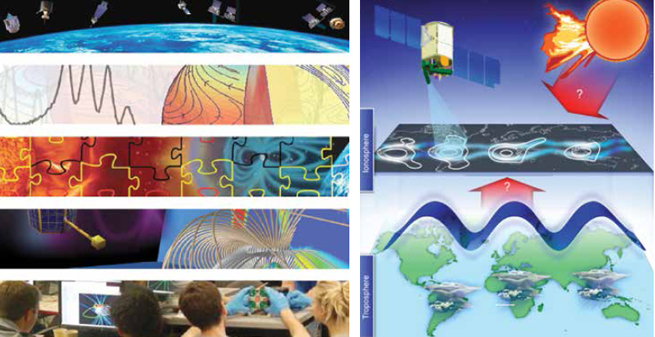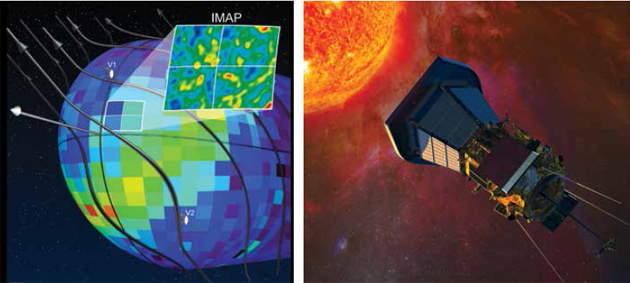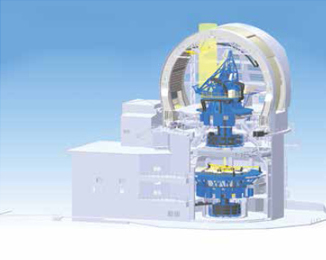HELIOPHYSICS: A SYSTEM SCIENCE
How Are Solar Magnetic Fields Created and Destroyed?
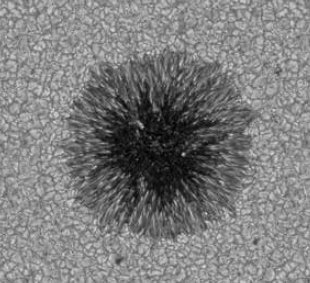
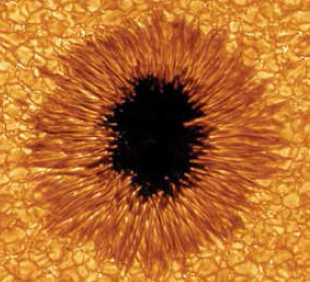
Numerical simulation of a sunspot (top) and an actual photograph (bottom) from the New Solar Telescope at Big Bear Observatory, NJIT. Sunspots are a consequence of intense magnetic fields on the surface of the Sun. Large sunspots can be tens of thousands of kilometers across.
A FUNDAMENTAL PROBLEM IN SOLAR PHYSICS—AND MORE GENERALLY IN THE UNDERSTANDING OF STARS—IS THE ORIGIN OF MAGNETIC FIELDS AND THEIR VARIATIONS. MAGNETIC FIELDS LIE AT THE ROOT OF SOLAR ACTIVITY—INCLUDING SPACE WEATHER. THEY PLAY A KEY ROLE IN SOLAR FLARES AND CORONAL MASS EJECTIONS, IN HEATING THE CORONA, IN ACCELERATING THE SOLAR WIND AND ENERGETIC PARTICLES, AND IN CREATING THE HELIOSPHERE.
The Solar Activity Cycle
One of the most striking features of the Sun is the presence of dark spots. Sunspots vary in number with a roughly 11-year period—the solar activity cycle. They can range in size—many are as big as Earth—and appear dark because they are cooler than their surroundings. Although systematically studied since the invention of the telescope in the early 17th century, it was not until the early 20th century that George Hale showed that sunspots are the visible manifestation of strong magnetic fields. These active regions, ultimately generated by churning plasmas deep within the Sun, store tremendous amounts of energy and lie at the heart of hazardous solar activity associated with explosive flares and dramatic coronal mass ejections. Even though new techniques are revealing conditions beneath the solar surface, an unanticipated lull in solar activity in 2008-2009 delayed the start of Solar Cycle 24, the weakest cycle in more than a century. We apparently have only a rudimentary scientific understanding of the origins and cyclic evolution of magnetism caused by the Sun’s dynamo motion.
A key question* for future research is, What are the detailed origins of the solar cycle?
The Corona: A Coupled Dance of Plasma and Field
The Sun’s outer atmosphere, the corona, is hundreds of times hotter than the visible surface of the Sun. In the corona, even the heaviest atoms are stripped of their electrons and form plasma, an electrically conductive gas of electrons and ions. The million-degree corona is most vividly observed in certain ultraviolet and X-ray wavelengths emitted by ions of particular elements at specific temperatures (see the figure). The Sun’s magnetic field permeates the corona and dominates the plasma’s dynamic behavior. The evolving field determines the coronal density and temperature structure, creates the solar wind, triggers flares and coronal mass ejections, and regulates the acceleration of energetic particles that fill the solar system. However, scientists struggle to explain just how energy flows into and through the corona, especially the thin enigmatic interface between the solar surface and corona.
A key question for future research is, How is energy transferred through the solar atmosphere to the rest of the solar system?
_______________
* The key science questions are derived from the more detailed goals and challenges that are presented in the full report.
Magnetic Explosions
The Sun’s magnetic field is in a state of perpetual change. Small patches of strong magnetic field constantly emerge from deeper layers, twisting, stretching, and jostling. Energy is stored when magnetic fields interact (think about stretching tangled elastic bands). If conditions are right, oppositely directed magnetic field lines can reconnect and release some of the stored energy in a violent explosion. Near the Sun’s surface, magnetic reconnection can trigger solar flares, heating the corona to 20 million degrees, producing intense X-ray radiation, and accelerating electrons and ions to nearly the speed of light. The corona’s magnetic fields can also destabilize on a near-global scale, triggering a coronal mass ejection—a billion-ton eruption of magnetized plasma traveling into interplanetary space at speeds of hundreds to thousands of kilometers per second.

Ultra-high-resolution numerical simulation of a coronal mass ejection and associated flare. Colored loops show the magnetic field. White contours indicate regions of high electric-current density. Note the sheets of intense current at the site of the flare, above the short loops near the solar equator, where reconnection occurs. The current sheet lies at the base of the erupting plasmoid, outlined in blue. The material ejected in a coronal mass ejection takes 2 to 4 days to reach Earth.
These space weather events threaten astronauts in space, satellites in orbit, long-distance communication, and electrical infrastructure on the ground. Particularly worrisome is the massive damage intense space weather can cause to the world’s electrical grid systems. Thanks to improving instrumentation and analysis capabilities, forecasters can identify where on the Sun magnetic explosions are likely to occur, but scientists cannot reliably predict when or how large events will be or whether the energetic particles and magnetized plasma will be strongly coupled to Earth.
Magnetic reconnection is a crucial process in both the heliosphere and Earth’s magnetosphere as well. A better understanding of magnetic reconnection is crucial to advancing our understanding of these and other astrophysical systems.
A key question for future research is, What is the role of magnetic reconnection in energy release in coronal mass ejections and flares?
How Does Earth’s Magnetosphere Store and Release Solar Energy?
Earth’s Magnetic Shield
The magnetized solar wind creates the heliosphere within the interstellar medium. Likewise, Earth’s magnetic field carves out its own local domain within the heliosphere. Just as the heliosphere deflects and absorbs external galactic particles and fields, our own magnetosphere deflects and absorbs solar particles and fields. The magnetosphere is the fundamental element of a complex system surrounding Earth that processes solar energy; it protects our planet from much of the solar wind and mediates the influence of solar variability on the Earth system. The lower boundary of the magnetosphere is the ionosphere, the tenuous region of Earth’s upper atmosphere ionized by solar radiation.
Earth’s magnetic field controls the motion of the electrically charged particles that become trapped in the magnetosphere. Shaped externally by the solar wind, the magnetosphere ordinarily extends out only 10 Earth radii—some 40,000 miles—on the sunward side of Earth, but well beyond the Moon’s orbit (approximately 60 Earth radii) on the side away from the Sun, forming a much longer magnetotail. Earth’s magnetosphere responds dynamically and dramatically to solar variability. It is buffeted by gusts in the solar wind and coupled by reconnecting magnetic fields to solar wind mass, momentum, and energy flow.
A key question for future research is, What are the interactions and feedbacks that connect the magnetosphere, solar wind, and ionosphere?

Earth’s ionosphere, thermosphere, and magnetosphere react together to the arrival of a coronal mass ejection. During strong magnetic storms, ionospheric plasma (green) can flow out of Earth’s polar regions and fill the magnetosphere, sometimes exceeding the density of incoming solar wind plasma (yellow) that gets through the magnetopause. Note: The Sun and the Earth are not shown to scale.
Variable Radiation Belts
The highest-energy plasma trapped within the magnetosphere collects in Earth’s radiation belts. The energetic plasma particles persistently degrade satellites in high-altitude orbits, including global positioning system (GPS) and communication satellites. Earth’s radiation belts are surprisingly volatile, sometimes so intense that they threaten satellites, or so weak that they seem almost to disappear. To understand these fluctuations requires better knowledge of the sources of radiation belt plasma and the processes driving that plasma.
The magnetosphere has no internal plasma sources, but traps plasma from external sources. The solar wind injects huge quantities of plasma into the
radiation belts, with lesser amounts contributed by the ionosphere below. Once trapped in the magnetosphere, the ions and electrons in the plasma can be accelerated to very high energies. Magnetic field reconnection in the tail of the magnetosphere and powerful plasma-wave interactions within the magnetosphere are two of the processes that energize radiation-belt particles. Geomagnetic storms—often caused by coronal mass ejections in the solar wind striking the magnetosphere—trigger these mechanisms, sometimes supercharging the radiation belts and threatening space- and ground-based electronics. Understanding how these processes interact and feed back in this complex system is crucial to explaining and predicting variations in the magnetosphere.
A key question for future research is, How are plasmas produced, lost, and energized in the magnetosphere?
Many Magnetospheres
Six planets (Earth, Mercury, Jupiter, Saturn, Uranus, and Neptune) and at least one moon (Jupiter’s Ganymede) are known to have magnetospheres. Each provides a unique laboratory for testing theories and models and, in particular, refining the scientific understanding of Earth’s magnetosphere. For example, a comparison of how energy from the solar wind is coupled into the magnetospheres of Earth and Mercury demonstrates the important role of an ionosphere, which is present on Earth but not on Mercury. The moons of Saturn and Jupiter inject plasma from within those planets' large and powerful magnetospheres, providing new insights into the effects of plasma sources. Saturn’s magnetosphere even emits radio emissions at regular intervals that were originally thought to represent the internal rotation rate of the planet but now appear to be affected by plasma processes. The magnetospheres of Uranus and Neptune are largely unexplored. These other systems present a suite of vastly different conditions, offering a chance to deepen our understanding of the fundamental processes at work in all magnetospheres.
A key question for future research is, How do other planetary magnetospheres interact with their ionospheres, atmospheres, and the solar wind?
How Does Earth’s Atmosphere Couple to Its Space Environment?
The Ionosphere-Thermosphere Connects Earth and Space
The connection between Earth’s atmosphere and conditions in space can be best understood when viewed as a system. The neutral atmosphere, ionosphere, magnetosphere, the solar wind, and radiation environment interact with each other, giving rise to new behaviors. The lowest layer—the troposphere—is home to all life, weather, and 80 percent of the atmosphere’s total mass. The top layer of the atmosphere—the thermosphere—consists of very low-density, high-temperature neutral gas heated by solar ultraviolet radiation. The ionosphere is the ionized component of the upper atmosphere; it overlaps with the thermosphere and is where the atmosphere begins to connect to space, at around 100 km above the surface. Both of these regions play key roles in modifying and producing space weather effects near Earth.
Understanding and being able to predict the state of the ionosphere is of central importance, because radio waves can be scattered and absorbed there. For example, GPS navigation and over-the-horizon communication used on long-duration airplane flights are affected by conditions in the ionosphere. Because the ionosphere is influenced both by conditions in space and by the atmosphere that extends down to the surface, a number of competing effects observed in this region must be understood in order to predict the behavior of the near-Earth space environment.
A key question for future research is, How does Earth’s atmosphere couple to its space environment?
AUGUST 3, 2010 GEOMAGNETIC STORM

A plasma storm envelops the North American continent on the afternoon of August 3, 2010. Red regions of high electron density degrade the performance of GPS systems used for navigation. Electric currents above Earth (shown by contours) also grow during the storm, inducing currents in the ground.
The Upper Atmosphere and Its Interactions with the Magnetosphere
The magnetosphere acts as an intermediary between space and the atmosphere, both preventing radiation from reaching Earth and transferring energy from the high-speed solar wind to the ionosphere and thermosphere. This energy in the ionosphere-thermosphere system circulates the neutral and charged gas of the layers and affects the density of both. In addition, magnetospheric fluctuations driven by the solar wind produce auroras. Precipitation of magnetospheric plasma along the magnetic field lines down into the atmosphere leads to collisions with the neutral atmosphere that emit auroral light. The aurora in turn drives stronger winds and raises temperatures in the thermosphere. Because the thermosphere and ionosphere occupy the same region of space, this magnetospheric energy is readily exchanged between the neutral and charged gas. From this dynamic interplay between the ions and neutrals emerge behaviors of the geospace system that are currently difficult to predict; understanding the coupling between the ions and neutrals in the upper atmosphere is therefore of key importance.
A key question for future research is, How does the ionosphere-thermosphere system regulate the flow of solar energy throughout geospace?

A remarkable example of lower-upper atmospheric coupling is seen in the ionospheric signature of the 2011 Moore, Oklahoma, tornado. Within minutes of the formation of the supercell that spawned the F5 tornado, concentric waves were seen in ionospheric densities (measured in total electron content) over North America at 300 km altitude, emanating outward more than 1,500 km from Oklahoma for the next 12 hours.
Effects of the Lower Atmosphere in Near-Earth Space
A surprising finding of the past decade is that day-to-day terrestrial weather affects conditions in space near Earth. In fact, phenomena in the lower atmosphere, including powerful storm systems, high winds over mountains, tropical rainy seasons, and even changes in the polar vortex, have all been connected to changes in the ionosphere and upper atmosphere. Energy is carried upward from these sources in atmospheric waves, and the size of these waves grows with increasing altitude to strongly influence conditions in the middle and upper atmosphere. The ionosphere is then affected by coupling between the neutral particles and charged plasma. Similar to the external disturbances driven by the solar wind, forcing from below has the potential to interfere with day-to-day use of precision GPS and other satellite-based technologies.
A key question for future research is, How do terrestrial weather and climate affect conditions in near-Earth space?
How Does the Sun Carve Its Place in the Galaxy?
The Source of the Heliosphere
In addition to its beauty, a total solar eclipse reveals the corona, the source of the solar wind. The solar wind extends into the solar system and beyond, creating a cavity in the interstellar medium called the heliosphere, as depicted in the figure. In fact, the solar wind and heliosphere extend more than four times the distance to Pluto, where the solar wind collides with the interstellar medium. At this boundary, called the heliopause, our home in space ends and the rest of the universe begins. All the planets of the solar system, including the Earth, are embedded deep inside the Sun’s extended stellar atmosphere.
Just like the Sun’s magnetic field, the heliosphere is incredibly dynamic and turbulent. The Sun’s magnetic field heats the corona and accelerates the solar wind toward the edge of the heliosphere, linking the solar interior to the galaxy. Explosive releases of energy stored in magnetic fields—solar flares and coronal mass ejections—can inject huge quantities of fast-moving material into the heliosphere.
A key question for future research is, How does the Sun’s magnetic field shape the dynamic heliosphere?

The July 11, 2010, solar eclipse reveals the magnetic structure of the inner corona. A superposed image shows the Moon blocking out the solar photosphere. Bright, closed magnetic loops generally indicate sources of high-density, slow-speed solar wind. Extended radial features are associated with high-speed streams above coronal holes at the poles and elsewhere. The shape of the Sun’s atmosphere changes through the solar cycle. The coronal structure imprinted on the solar wind is ultimately carried out to the edge of the heliosphere.
The Boundary of the Heliosphere
The outer regions of the heliosphere are rich in unexplored physics. One region—the heliosheath—magnetically shields the solar system from some of the galactic cosmic rays that permeate interstellar space. Because these high-energy cosmic rays consist of charged particles, the magnetic field of the heliosheath regulates their flow into the inner heliosphere. However, magnetic shocks in the outer heliosphere also energize additional, “anomalous” cosmic rays.
Cosmic rays can be harmful to life, because they can break down DNA molecules. They also stimulate evolution by increasing the rate of cell mutation. Additionally, cosmic rays may play some role in climate variability, although this relationship remains highly controversial. Though the details remain uncertain, our own heliosphere provides an astrophysical case history of the successful emergence of life in a hospitable environment. The study of heliospheres around other stars, called “astrospheres,” can inform the search for habitable planets in other stellar systems. Thus, scientists seek a better understanding of our own heliosphere’s role in shaping past and future conditions on Earth.
Recently, a pair of 35-year-old spacecraft, the Voyagers, collected the first direct measurements of the heliopause region, while at the same time the IBEX mission demonstrated new methods for imaging the entire outer boundary of the heliosphere from near Earth. New data from these missions are revolutionizing the understanding of the edge of our solar system. During the next decade, as the Voyager spacecraft pass through the heliopause and enter interstellar space, they will send back measurements as the first human craft to leave our solar system. Unfortunately, the Voyagers will become inoperable in the 2020s, when their electrical power becomes inadequate to support science instrument operation. Therefore, the coming decade is a critical window for discovering how the Sun interacts with the local galactic medium.
A key question for future research is, How does our Sun interact with the interstellar medium?

Images of the heliospheres around other stars (called astrospheres) observed with a variety of telescopes.

